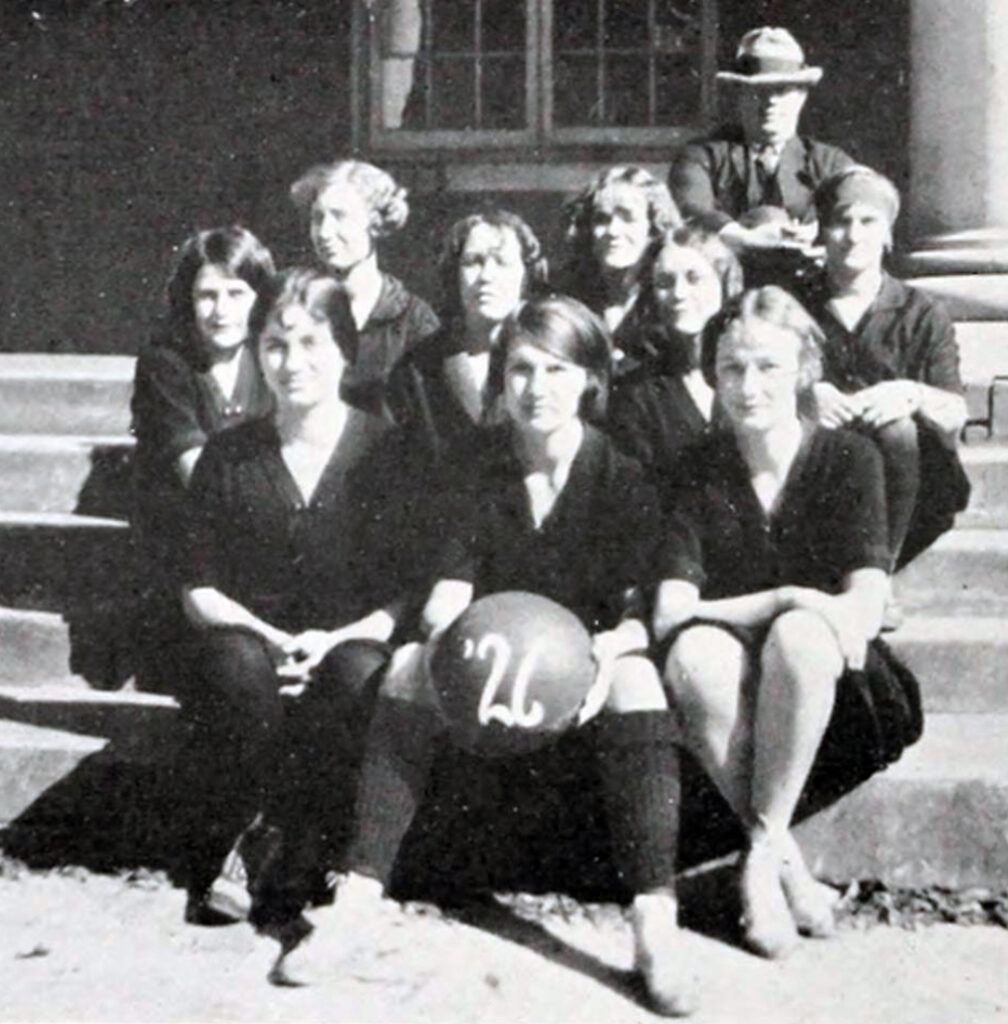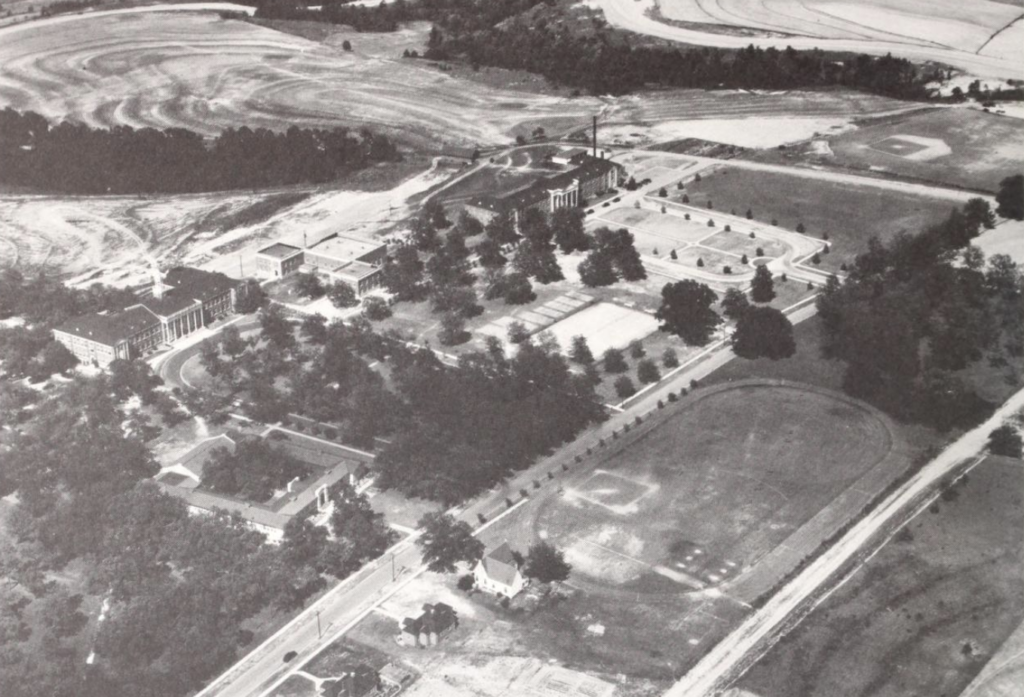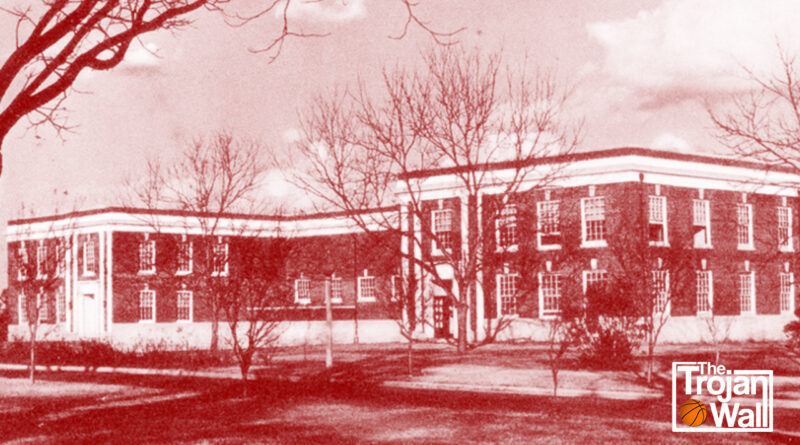Homecoming on the Court: The First Home of Troy Basketball
In the 1920s, Troy State Normal College was roaring, growing and moving. Those changes impacted the basketball team, keeping them off campus until just before World War II.
The 1922 Palladium mentions the women’s games being played “on the SNS campus,” but that’s the last record of an exact location for any basketball game for more than a decade. Game photos don’t exist before the 1947-48 season, and newspaper records aren’t that specific.
Earlier that year, the wheels began turning to move Troy State College away from its downtown location. The State of Alabama approved the purchase of a 275-acre lot where the current campus sits. Part of the purchase included giving the downtown building back to the city.
(Note: “Grand Plans” is an exceptional read for anyone interested in Troy University history.)
In August 1922, President Edward Shackelford made an agreement with the Olmstead Brothers to develop the land, but it took five years for funding. In the meantime, Shackelford funded and built Kilby Hall on the west side of the current quad.
Five years, later the state put more than $5 million toward buildings around the state and hired the Olmstead Brothers firm to make them happen. In 1928, the firm began work on Troy’s new location, as part of that project.



Now-John Lewis Hall was the second building constructed on campus, followed by Shackelford, and the two respective quads.
The long wait and eventual shift impacted the basketball teams as well as classes. It’s unknown whether the city let Troy keep using its downtown building after Kilby Hall was completed in 1924.

In that time though, the “cagers” struggled to find a usable venue for practice and play.
Both the 1922 and 1926 yearbooks, each bookending the completion of Kilby Hall, use the exact same wording to describe the state of the basketball teams: “somewhat handicapped by the lack of basketball material,” and “started to shooting the old goals.”
Just read the first two lines of each paragraph here:


The 1929 Palladium says the men’s team “were handicapped by the lack of an indoor court,” and by September 1930 the campus was holding classes in its final, new location.
The basketball team soldiered on, playing games off-campus whether home or away. The men split a series with Georgia Southern in 1931, one of which was in Troy, and in 1935 the Montgomery Advertiser mentions a game against Sidney Lanier’s YMCA.

That same year, the Troy Messenger reported that Troy was being admitted to the Southern Intercollegiate Athletic Association, a predecessor to the NCAA that reformed into a conference when its founding members broke off to form the Southern Conference and cycled through nearly every Southern college known to man.
The report said “basketball has never been part of the college’s program,” despite yearbook records of teams dating back to at least 1912.
Regardless, the campus continued to expand. The lagoon and roads around campus were built, filling out the college’s look. Still, the basketball team had no place to call home.
They had a place in line, though.

Before Shackelford took the reigns, Troy Athletics was always considered an extracurricular activity, like a club, coming second to studies. Around the time Troy moved campuses, he learned that more than 100 students came to campus because of the teams.
The book “Beyond the Normal” says Shackelford credits athletics with saving the college in the mid-1930s, and it’s clear his priorities changed. Pace Field became one of the first baseball fields in Alabama with lighting, and the golf course was excavated to the north of campus.
It’s also worth noting the Olmstead Brothers’ plans put a football and track stadium right where the Vet is today.
In March 1939, the Dothan Eagle reported that Troy would get $84,000 to build a physical education building. It’s the building right next to Lewis Hall in the picture above, and its design included a basketball gym.
It was built very quickly.
By January 1940, Wright Hall became the new home of Troy basketball.



The February 1, 1940 issue of the Troy Messenger noted that basketball was back on campus “after a more than ten-year layoff,” though the exact date isn’t known. The closest confirmed game date and opponent was the Greenville Athletic Club on January 29, a 52-41 win for Troy.
It’s nice to think the Wright Hall era began on the right foot.
The basketball teams more than likely followed the football team’s lead during the war, disbanding for the time, but the team was back on the court for good by 1946, when rival Jacksonville State handed Troy two losses.
Then came Coach “Buddy” McCollum.

